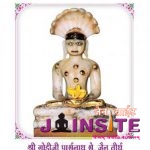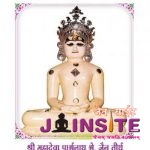- Ranakpura Parshwanath
Post-Ranakpur, Dist-Pali, State-Falna
Mulnayak: Nearly 48 cms. high, beautifully and artisticically carved Parrikar Yukt black – coloured
idol of Bhagwan Parshvanath in the Padmasana posture. There is an umbrella of 7 hoods over the
head of the idol. This Parrikar is a beautiful piece of art minutely carved by the artisans.
Tirth: The Ranakpur temple is in the heart of the remote and enchanting valley of the Arvalli hills
skirting the rivulet Maghai and enveloped in the solitude of the surrounding forest standing in
solemn grandeur.

Historicity: Acharya Somsundarsuriji was a magnetic personality who lived in the 15th century of
the Vikram Era. Shresthi Dharnashah came into contact with Acharya Somsundarsuriji who infused
a strong spiritual urge in his heart. At the age of twenty – one, when he visited Shatrunjaya, the
foremost among all the places of Jain pilgrimage, Dharnashah, along with his wife, took the
austere vow of lifelong celebacy. Aided by his sharp intellect, a keen administrative power and an
innate capacity to lead and govern, he had risen to the position of a Minister to King Rana
Kumbha. One blessed day Dharnashah felt the spontaneous urge to build a temple of Lord
Rishabhdev also known as Adinath, the first Thirthankara, which he resolved, should be without
parallel in beauty. A legend tells us that one night in his dream, Dharnashah had a vision of "Nalini
Gulm Viman" (it is in the twelfth devlok) which is considered to be the most beautiful among the
celestial abode of Devas. Dharnashah decided that the temple should resemble this heavenly
abode. So, he purchased land from Rana Kumbha and established a village by the name “Ranpur”
which later came to be called as Ranakpur. He called artisans from near and far places and asked
them to construct a temple in according to his dream. A beautiful and gorgeous three storeyed
Chaturmukha temple took shape. The carvings of this temple is unparalleled and incomparable all
over the world. The foundation stone was laid in the year 1433 of the Vikram era. There are 1444
pillars. The whole temple is on pillars.The workmanship of each pillar is different. The temple is so
artistically built that one can see God’s face from any corner and not a single pillar comes in the
way and the ventilation is equally good everywhere. This temple has 84 idols. They suggest that 84
rotations of the wheel of this world can be got rid of here. This temple came to be known as
“Dharan Vihar” or “Trailokya Deepak Prasad”. The temple is also known as “Tribhuvan Vihar”,
“Nalini Gulm Viman” “Chaturmukha Prasad” etc. Exactly opposite to the main temple is the alluring
temple of Bhagwan Parshvanath facing North. This temple was built in 15th century. It is said that
when the work on the main temple was going on, the artisans during their leisure time started
working on this temple with the extra material that was there. The idol of Parshvanath was installed
in this temple. This Parshvanath came to be known as “Ranakpur Parshvanath”. A fair is held here
on Karthik Purnima, Phalgun Purnima and Chaitri Purnima every year.
Other Temples: The main temple is of Bhagwan Adinath. There were 6 other temples here. But
today only 3 temples are there. The other 2 temples are of Bhagwan Neminath and Bhagwan
Parshvanath. The sun temple and the temple of Chakreshvaridevi are also there.
Works of art and Sculpture: From artistic and cultural viewpoints, the whole temple is beautiful,
splendid, matchless and outstanding among many wonders of the world. The Chaturmukha Jain
Temple of Ranakpur on a lofty plinth, the three-storeyed marble edifice, to which the genius of the
artist has imparted exquisite artistic grace, and which his deep devotion has endowed with serene
spiritual dignity is, verily, a poem in stone. Majestic yet in complete harmony with Mother Nature, in
whose beautiful lap it rests, this magnificent monument of devotional architecture seems bathed in
celestial bliss. The very hills around, dwarfed by its imposing bearing, appear absorbed in mute
meditation, as if spell-bound. The concord achieved between the bounteous generosity of Nature
and man's creative expression of gratitude, stands uniquely symbolised in this Divine Creation. To
behold this holy shrine in its spectacularly sublime setting, is to experience instant uplifting of the
soul. In the temple, there are many things worth seeing. From the top of the steps of the chief gate
(the western gate), one sees very splendid carvings of leaves of the wish – fulfilling tree
(Kalpavriksh). The carvings on the leavse fulfil the wishes of the pilgrims. On entering the temple,
one sees to the right the idol of the mason, a native of Mandara. He was a yogi and lived in
Sadhu’s dress. By the grace of his goddess, he made a plan of this temple. His descendents live
there even today. They do the rapairing work of the temple. To the left inside the temple, there is an
idol of Dharna Shah. His idol is made in a pillar so as to avoid the propaganda of his name and
always he able to see God well. The Rayan tree which was planted by Dharna Shah 500 years
ago, is present even today. The idols of the feet of Bhagwan Risabhdev are there to remind us that
Bhagwan Risabhdev attained omniscience under a Rayan tree. In the center to the right of the
temple, Samavasaran of Bhagwan Mahavir is very artistically constructed with marble stone. When
Bhagwan is giving sermons, the audience is sitting on three sides. The idols in the ceilings of the
gates to the east and to the west have one head and five bodies. The incident of the harassment
caused by Kamath to the thousand hooded Parshvanath is very artistically carved. The tails of
male snakes and female snakes are shown entangled. Sixteen female snakes help the male
snakes to protect Bhagwan. The tails of male snakes and female snakes are very artistically
interwoven and it seems that there is net – work of tails. It is a special feature of this workmanship
that the whole carving is done on a single stone. The model of Shatrunjay was well designed to
give an artistic description when the means and resources were not scientically developed. The
workmanship of the model is beautiful and praiseworthy. The idol of Bhagwan Parshvanath is
made out of touchstone. The dolls in the domes are very splendid. It is praiseworthy that the
incident of harassment to Bhagwan Parshvanath is very vividly depicted. The temple is so minutely
sculptured that in the cold season, one does not feel cold in the temple and in the hot season, one
feels cold in the temple. In the construction of the temples, walls are not used at all. The two pairs
of bells are made of metal and they weigh 13 maunds. In each pair, one is a male and the other is
a female. One produces a low sound and the other produces a heavy sound. The sound reaches
as far as three miles. The sound of Om is produced in a lotus in the form of a navel and passes
into the aperture at the crown of head. It lasts for one minute. The chandelier on the ceiling of the
open square of the temple is pulled low at the center. This cannot be imagined. How the weight of
stones is kept hanging unsupported, is a puzzle.
Guidelines: The nearest railway station of Falna is at a distance of 35 kms. and the nearest town
of Sadadi is at a distance of 10 kms. Bus service and private vehicles are available. The nearest
airport, Udaipur, is at a distance of 90 kms. and Jodhpur is at a distance of 170 kms. There is a
vast dharmashala near the temple. Another Dharamshala is also there. There is a bhojanashala
also. There are guest – houses also equipped with modern facilities. Bus facilities are available
from Udaipur, Abu, Jalore and Nakoda.
Scripture: There is an inscription in the main temple of Adinathof of V.S.1496,which shows the
antiquity of this temple. A mention of the temples of Ranakpur is made in "Ranigpur Chaturmukh
Prasad Stavan ", in "Shri Sankheswar ParshvanathChaand", in "Tirth Mala", in "108 Naamgarbhit
Shri Godiji Parshvanath Stavan", in "Shri Hirvijaysuri Raas", in "Tirthmala Stavan", in "108
Naamgarbhit Shri Parshvanath Stavan", “135 Naamgarbhit Shri Parshvanath Stavan”, “Ranakpur
Tirth Stavan” etc. The history and splendour of this temple is beautifully mentioned in "Som
Sowbhagya Kavya".
Trust: Shri Ranakpur Parshvanath Shwetambar Jain Tirth, Sheth Shri Anandji Kalyanji Pedhi,
Post: Ranakpur – 306 702, District: Pali, Station: Faalna, State – Rajasthan, India.
BOOK NOW
श्री राणकपुरा पार्श्वनाथ
श्री राणकपुर पार्श्वनाथ – राणकपुर
राजस्थान के पाली जिले में राणकपुर तीर्थ के मुख्य जिनालय धरणी विहार के ठीक सामने उत्तरभिमुख श्री राणकपुरा पार्श्वनाथ प्रभु का भव्य जिनालय है| प्रतिमाजी श्याम वर्णीय, सात फनों से युक्त १९ इंच ऊँचे व १५ इंच चौड़े है|
इस जिनालय का निर्माण लगभग १५वीं सदी में हुआ था| ऐसा कहा जाता है की धरण विहार नाम के मुख्य जिनालय के निर्माण के बाद बची सामग्री में से शिल्पियों ने इस जिन प्रसाद का निर्माण किया था| इस मंदिर के निर्माता धरणाशा क्षेष्ठी है|







